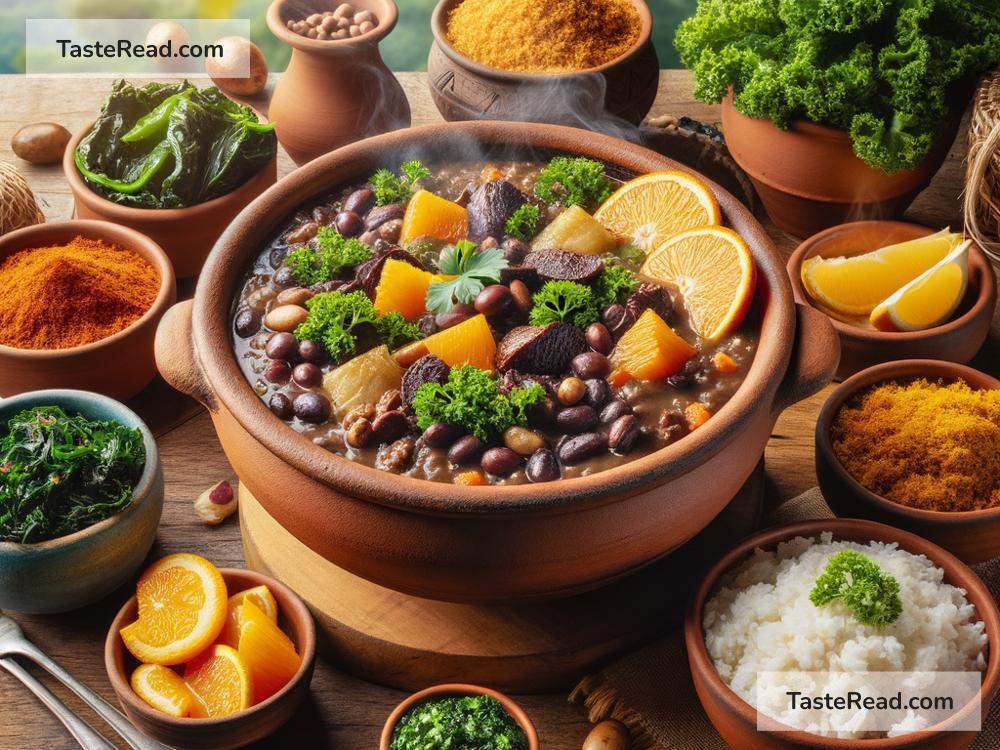The Story of Brazilian Feijoada: Brazil’s National Dish
Brazil is a country full of color, music, and delicious food. One dish that stands out above the rest is feijoada (pronounced fay-zhoo-AH-dah). It is often called Brazil’s national dish, and it has a story as rich as its flavor. Feijoada is not just food—it’s a symbol of family, culture, and the country’s history. In this article, we’ll dive into the story of how feijoada came to be, what’s in it, and why it is so special to Brazilian people.
What is Feijoada?
Feijoada is a hearty stew made with black beans, pork, and beef. The dish is slow-cooked so that all the flavors blend together. It is usually served with rice, fried kale, orange slices, and sometimes farofa (toasted cassava flour). Brazilians love to eat feijoada during large gatherings or weekend lunches, since it’s a dish that brings people together.
The name “feijoada” comes from the Portuguese word feijão, which means “beans.” Beans are the main ingredient in the dish, and they have been a staple food in Brazil for centuries. But feijoada is more than just beans—it is a combination of ingredients that tell a historical story.
The Origins of Feijoada
Like many dishes around the world, feijoada has a mixed and debated origin. The most popular story connects the dish to Brazil’s colonial history. Brazil was colonized by Portugal in the 1500s, and during this time, millions of Africans were brought to Brazil as enslaved workers. Feijoada is often believed to have roots in the enslaved African communities.
According to this legend, enslaved workers used scraps and leftover ingredients to make their meals. Wealthy colonizers kept the best cuts of meat for themselves, leaving the undesirable parts—like pig’s ears, feet, tails, and other scraps—for the enslaved workers. These pieces were boiled together with beans to create a filling and flavorful stew. Over time, this simple dish evolved into the refined and celebrated feijoada that Brazilians enjoy today.
Another theory is that feijoada was inspired by traditional stews from Europe, especially Portugal. For example, Portuguese dishes like cozido (a stew made with meat and vegetables) may have influenced feijoada. Whether the dish came from African ingenuity or European traditions—or perhaps a mix of both—feijoada has become a uniquely Brazilian creation.
What Makes Feijoada Unique?
While feijoada has historical roots, it also reflects the diversity of Brazilian cuisine. Brazil is full of different cultural influences, including African, Portuguese, Indigenous, and more. Each of these cultures has shaped Brazilian food, and feijoada is a perfect example of this blending.
What sets feijoada apart is the way Brazilians prepare and enjoy it. Feijoada is not just about eating—it is about gathering friends and family, sharing stories, and celebrating life. In Brazil, cooking feijoada is an event that takes hours. The slow cooking process is key to bringing out the flavors. The dish is usually made in large pots and shared with many people, often accompanied by music and laughter.
It’s also customary to serve feijoada with side dishes that complement its richness. White rice helps balance the savory beans, kale adds freshness, and orange slices provide a bright, acidic note that cleanses the palate. Farofa, a crunchy topping made from cassava flour, adds texture to the dish. Together, this combination makes every bite of feijoada exciting and delicious.
Feijoada Today
Today, feijoada is enjoyed all over Brazil and even around the world. While the basic recipe remains the same, different regions and families have their own versions of the dish. For example, some cooks add smoked sausage, bacon, or ribs to enhance the flavor. Others may skip certain ingredients to make it simpler.
In Brazil, feijoada is often served in restaurants on Wednesdays and Saturdays, which have become unofficial feijoada days. People look forward to these days as a time to gather and enjoy good food with friends. Feijoada is not just popular with Brazilians—tourists who visit Brazil almost always fall in love with the dish, too.
Feijoada has grown beyond its humble beginnings to become a proud symbol of Brazilian identity. The dish shows the creativity and resilience of the people who made it, as well as the diversity of Brazilian culture.
Conclusion
Feijoada is much more than a black bean stew. It’s a dish with deep roots in Brazil’s history and culture. Whether you believe it came from the resourcefulness of enslaved African workers or the influence of Portuguese settlers, feijoada is a testament to how food can bring people together.
If you ever visit Brazil, be sure to try feijoada—it’s a flavorful journey through the country’s past and present. And if you can’t make it to Brazil, many recipes are available online so you can try making feijoada at home. Just don’t forget to take your time cooking it and enjoy it with loved ones. After all, feijoada is not just a dish—it’s a celebration.


